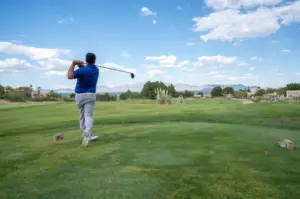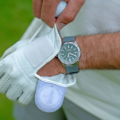Golfers of all skill levels have experienced the frustration of hitting shots that veer off course, whether they end up slicing to the right or hooking to the left. These errant shots can lead to lost balls, penalty strokes, and a general loss of confidence on the course. Understanding the difference between a slice and a hook, as well as the causes behind them, is essential for golfers looking to improve their game and minimize these wayward shots.
What is a Golf Slice?
A golf slice is a shot that curves sharply to the right for right-handed golfers (or to the left for left-handed golfers). It is characterized by a ball flight that starts relatively straight but then veers off to the right in an uncontrolled manner. Slices are often the bane of beginner golfers, but even experienced players can struggle with this shot shape.
The main cause of a slice is an open clubface at impact. When the clubface is open, it promotes sidespin on the ball, causing it to curve to the right. Additionally, an outside-to-inside swing path can exacerbate the slice, as it further accentuates the sidespin. This combination of an open clubface and an outside-to-inside swing path leads to the classic slice shot shape.
What Causes a Golf Slice?
There are several factors that can contribute to a golf slice. Let’s take a closer look at each of these factors and how they can be addressed:
Grip
One of the most common causes of a slice is an incorrect grip. A grip that is too weak (where the hands are rotated too far to the left for a right-handed golfer) can result in an open clubface at impact. On the other hand, a grip that is too strong (where the hands are rotated too far to the right) can restrict the release of the club and also lead to a slice. Finding a neutral grip, where the hands are positioned comfortably on the club, is key to reducing the chances of slicing the ball.
Alignment
Proper alignment is crucial in golf, and misalignment can contribute to a slice. If a golfer sets up with their feet, hips, and shoulders aimed too far to the left of the target (for a right-handed golfer), it can encourage an outside-to-inside swing path and an open clubface at impact. Ensuring that your alignment is parallel to the target line can help promote a more square clubface and a straighter ball flight.
Swing Path
The path that the clubhead travels on during the swing can greatly influence the ball flight. An outside-to-inside swing path, where the clubhead approaches the ball from the right of the target line (for a right-handed golfer), can result in a slice. This swing path encourages an open clubface at impact and promotes sidespin on the ball. Working on swinging on a more neutral or inside-to-outside path can help reduce the chances of slicing.
Weight Distribution
Proper weight distribution throughout the swing is essential for a consistent ball flight. If a golfer’s weight stays predominantly on their back foot during the downswing, it can lead to an outside-to-inside swing path and a slice. Ensuring that the weight shifts to the front foot during the downswing can help promote a more neutral swing path and reduce the chances of slicing.
How to Fix a Golf Slice
Now that we understand the causes of a golf slice, let’s explore some tips and techniques to help fix this common problem:
Grip Adjustment
If your grip is contributing to your slice, making a grip adjustment can be a simple yet effective solution. Experiment with different grip positions, aiming for a neutral grip where the hands are positioned comfortably on the club. This can help promote a more square clubface at impact and reduce the chances of slicing.
Alignment Check
Regularly checking your alignment during setup is essential for reducing slices. Use alignment aids such as alignment sticks or a target line on the ground to ensure that your feet, hips, and shoulders are parallel to the target line. This will help promote a more neutral swing path and minimize the chances of slicing.
Swing Path Correction
Working on correcting your swing path is crucial for reducing slices. Focus on swinging on a more inside-to-outside path, where the clubhead approaches the ball from the inside of the target line (for a right-handed golfer). This can be achieved by practicing drills and exercises that promote a more neutral swing path. Working with a golf instructor can also provide valuable guidance in correcting your swing path.
Weight Transfer
Improving your weight transfer during the swing can help reduce slices. Focus on shifting your weight to your front foot during the downswing, ensuring that your weight is evenly distributed at impact. This promotes a more neutral swing path and can help eliminate the outside-to-inside path that often leads to slicing.
What is a Golf Hook?
A golf hook is a shot that curves sharply to the left for right-handed golfers (or to the right for left-handed golfers). It is the opposite of a slice and is characterized by a ball flight that starts relatively straight but then veers off to the left in an uncontrolled manner. Hooks can be just as frustrating as slices, as they result in missed targets and lost distance.
The main cause of a hook is a closed clubface at impact. When the clubface is closed, it promotes sidespin on the ball, causing it to curve to the left. Additionally, an inside-to-outside swing path can exacerbate the hook, as it further accentuates the sidespin. This combination of a closed clubface and an inside-to-outside swing path leads to the classic hook shot shape.
What Causes a Golf Hook?
Similar to a slice, there are several factors that can contribute to a golf hook. Let’s take a closer look at each of these factors and how they can be addressed:
Grip
As with a slice, an incorrect grip can contribute to a hook. A grip that is too strong (where the hands are rotated too far to the right for a right-handed golfer) can result in a closed clubface at impact. On the other hand, a grip that is too weak (where the hands are rotated too far to the left) can lead to an open clubface and a slice. Finding a neutral grip is crucial for minimizing hooks and promoting a more consistent ball flight.
Alignment
Proper alignment plays a significant role in reducing hooks. If a golfer sets up with their feet, hips, and shoulders aimed too far to the right of the target (for a right-handed golfer), it can encourage an inside-to-outside swing path and a closed clubface at impact. Ensuring that your alignment is parallel to the target line can help promote a more square clubface and minimize the chances of hooking the ball.
Swing Path
The swing path is another critical factor in determining whether a golfer will hook the ball. An inside-to-outside swing path, where the clubhead approaches the ball from the inside of the target line (for a right-handed golfer), can result in a hook. This swing path encourages a closed clubface at impact and promotes sidespin on the ball. Working on swinging on a more neutral or outside-to-inside path can help reduce the chances of hooking.
Weight Distribution
Just like with a slice, proper weight distribution is crucial for minimizing hooks. If a golfer’s weight stays predominantly on their front foot during the downswing, it can lead to an inside-to-outside swing path and a hook. Ensuring that the weight shifts to the back foot during the downswing can help promote a more neutral swing path and reduce the chances of hooking.
How to Fix a Golf Hook
Now that we understand the causes of a golf hook, let’s explore some tips and techniques to help fix this common problem:
Grip Adjustment
If your grip is contributing to your hook, making a grip adjustment can be an effective solution. Experiment with different grip positions, aiming for a neutral grip where the hands are positioned comfortably on the club. This can help promote a more square clubface at impact and reduce the chances of hooking.
Alignment Check
Regularly checking your alignment during setup is essential for reducing hooks. Use alignment aids such as alignment sticks or a target line on the ground to ensure that your feet, hips, and shoulders are parallel to the target line. This will help promote a more neutral swing path and minimize the chances of hooking.
Swing Path Correction
Working on correcting your swing path is crucial for reducing hooks. Focus on swinging on a more outside-to-inside path, where the clubhead approaches the ball from the outside of the target line (for a right-handed golfer). This can be achieved by practicing drills and exercises that promote a more neutral swing path. Working with a golf instructor can also provide valuable guidance in correcting your swing path.
Weight Transfer
Improving your weight transfer during the swing can help reduce hooks. Focus on shifting your weight to your back foot during the downswing, ensuring that your weight is evenly distributed at impact. This promotes a more neutral swing path and can help eliminate the inside-to-outside path that often leads to hooking.
Conclusion
Understanding the difference between a golf slice and a hook is essential for golfers looking to improve their game and hit more accurate shots. While both shots can be frustrating and lead to lost strokes, the causes and fixes for each are distinct.
A slice is characterized by a ball flight that curves sharply to the right (for right-handed golfers) and is caused by an open clubface and an outside-to-inside swing path. To fix a slice, golfers should focus on adjusting their grip, alignment, swing path, and weight distribution.
On the other hand, a hook is characterized by a ball flight that curves sharply to the left (for right-handed golfers) and is caused by a closed clubface and an inside-to-outside swing path. To fix a hook, golfers should also focus on adjusting their grip, alignment, swing path, and weight distribution, but in the opposite direction.
By understanding the causes and implementing the appropriate fixes for slices and hooks, golfers can gain more control over their ball flight and enjoy more consistent and accurate shots on the course. Remember, practice and patience are key when working on these adjustments, so don’t get discouraged if progress is gradual. With time and dedication, you can overcome these challenges and improve your overall golf game.




